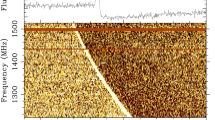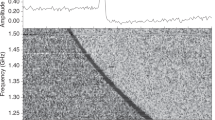Abstract
During the last six decades, several outstanding discoveries have been made in the field of radio astronomy. These have revolutionized our understanding of the mysteries of the Universe. Observations of radio galaxies and quasars that emit extremely powerful radio waves indicate presence of supermassive black holes at their centre. Discovery and detailed observations of the 2.7 K cosmic microwave background temperature have provided strong support to the Big Bang Model of the Universe, giving tight constraints on the relative contributions of baryons, dark matter and dark energy in the Universe. Observations of the emission line of neutral hydrogen from spiral galaxies provide information about the formation and evolution of galaxies. Over 150 molecules have been discovered in the interstellar medium, giving details about the physics and chemistry of the interstellar space; these are also ingredients of life in the Universe. Discovery of Pulsating Radio Sources (Pulsars) have provided strong support to the models of neutron stars that are end products of a star when its ‘nuclear fuel’ runs out. Observations of Pulsars also provide tests of the General Theory of Relativity. I also summarize some of the investigations that are being carried out currently with the Ooty Radio Telescope in South India and with the Giant Metrewave Radio Telescope near Pune; these are amongst the largest radio telescopes in the world. Finally, I describe some of the Key Questions today.
















Similar content being viewed by others
References
Jansky K (1933) Electrical disturbances apparently of extraterrestrial origin. Proc Inst Radio Eng 21:1387
Reber G (1940) Cosmic static. Astrophys J 91:621–624
Hey JS (1946) Solar radiations in the 4–6 metre radio wave-length band. Nature 157:47–48
Southworth GC (1945) Microwave radiation from the Sun. J Frankl Inst 239:285
Appleton EV, Hey JS (1946) Solar radio noise. Philos Mag 37:73–84
Pawsey JL, Payne-Scott R, McCready LL (1946) Radio-frequency energy from the Sun. Nature 157:158–159
Pawsey JL (1946) Observation of million degree thermal radiation from the Sun at a wavelength of 1.5 metres. Nature 158:633–634
Wild JP, McCready LL (1950) Observations of the spectrum of high-intensity solar radiation at metre wavelengths I, the apparatus and spectral types of solar bursts observed. Aust J Sci Res A 3:387–394
Wild JP (1950) Observations of the spectrum of high-intensity solar radiation at metre wavelengths. II. Outbusrsts. Aust J Sci Res A 3:399–408
Boischot A (1957) Caractères d’un type d’émission hertzienne associé à certaines éruptions chromosphériques. Comptes Rendus de l’Académie des Sciences, Paris 244:1326–1329
Wild JP, Sheridan KV, Trent GW (1959) The transverse motions of the sources of solar radio bursts. In: Bracewell RN (ed) Paris symposium on radio astronomy. Stanford University Press, Stanford, pp 176–185
Maxwell A, Swarup G (1958) A new spectral characteristic in solar radio emission. Nature 181:36–38
Christiansen WN, Warburton JA (1955) The distribution of radio brightness over the solar disk at a wavelength of 21 centimetres. III. The quiet Sun-two-dimensional observations. Aust J Phys 8:474–486
Bastian TS, Benz AO, Gary DE (1998) Radio emission from solar flares. Ann Rev Astron Astrophys 36:131–188
Bastian TS, Gary DE (2012) Observing the Sun at radio wavelengths: current status and future prospects, science with large solar telescopes. In: Proceedings of IAU special session 6 held 22–24 August 2012. http://www.arcetri.astro.it/IAUSpS6
Manoharan PK (2010) Ooty interplanetary scintillation—remote-sensing observations and analysis of coronal mass ejections in the heliosphere. Sol Phys 265:137–157
Hey JS, Parsons SJ, Phillips JW (1946) Fluctuations in cosmic radiation at radio-frequencies. Nature 158:234
Smith FG (1951) An accurate determination of the positions of four radio stars. Nature 168:551–553
Baade W, Minkowski R (1954) Identification of radio sources in Cassiopeia, Cygnus A, Puppia A. Astrophys J 119:206–214
Condon JJ et al (1998) The NRAO VLA sky survey. Astron J 115:1693–1716
Perley RA, Dreher JW, Cowan JJ (1984) The jet and filaments in Cygnus A. Astrophys J 285:L35–L38
Schmidt M (1963) 3C 273: a star-like object with large red-shift. Nature 197:1040
Antonucci R (1993) Unified models for active galactic nuclei and quasars. Ann Rev Astron Astrophys 31:473–521
Urry CM, Padovani P (1995) Unified schemes for radio loud AGN. Pub Astron Soc Pac 107:803–845
Hubble E (1929) A relation between distance and radial velocity among extra-galactic nebulae. Proc Natl Acad 15:168–173
Lemaître G (1927) Un Univers homogène de masse constante et de rayon croissant rendant compte de la vitesse radiale des nébuleuses extra-galactiques. Annal. Société Scientifique Bruxelles, A. Société Scientifique Bruxelles A 47:49–56
Hoyle F (1948) A new model for the expanding universe. Mon Not R Astron Soc 108:372–383
Bondi H, Gold T (1948) The steady-state theory of the expanding universe. Mon Not R Astron Soc 108:252–271
Ryle M, Clarke RW (1961) An examination of the steady-state model in the light of some recent observations of radio sources. Mon Not R Astron Soc 122:349–362
Swarup G, Sharma NVG, Joshi MN, Kapahi VK, Bagri DS, Damle SH, Ananthakrishnan S, Balasubrahmanya V, Bhave SS, Sinha RP (1971) Large steerable radio telescope at Ootacamund, India. Nat Phys Sci 230:185–188
Swarup G (1975) Angular size-flux density relation for extragalactic radio sources. Mon Not R Astron Soc 172:501–512
Kapahi VK (1975) Cosmology from angular size counts of extragalactic radio sources. Mon Not R Astron Soc 172:513–533
Swarup G, Kapahi VK, Velusamy T, Ananthakrishnan S, Balasubramanian V, Gopal-Krishna, Pramesh Rao A, Subrahmanya CR, Kulkarni VK (1991) Twenty-five years of radio astronomy at TIFR. Curr Sci 60:79–94
Manoharan PK (2006) Evolution of coronal mass ejections in the inner heliosphere: a study using white-light and scintillation images. Sol Phys 235:345–368
SkA Saiyad, Bharadwaj S (2014) Prospects for detecting the 326.5 MHz redshifted 21-cm HI signal with the Ooty Radio Telescope (ORT). J Astrophys Astron 35:157–182
Hawking S (1988) A brief history of time. Bantam Books, New York. ISBN: 0-553-38016-8
Penzias AA, Wilson RW (1965) A measurement of excess antenna temperature at 4080 Mc/s. Astrophys J 142:419–420
Mather JC et al (1990) A preliminary measurement of the cosmic microwave background spectrum by the Cosmic Background Explorer (COBE) satellite. Astrophys J Lett 354:L37–L44
Mather JC et al (1994) Measurement of the cosmic microwave background spectrum by the COBE FIRAS instrument. Astrophys J 420:439–444
Smoot GF (1992) Structure in the COBE differential microwave radiometer first-year maps. Astrophys J Letts 396:L1–L5
Bennett CL et al (2004) First-year Wilkinson microwave anisotropy probe (WMAP) observations: preliminary m maps and basic results. Asrophys J Suppl 148:1–27
Bennett CL et al (2013) Nine-year Wilkinson microwave anisotropy probe (WMAP) observations final maps and results. Astrophys J Suppl Ser 208:20
Spergel DN et al (2003) First-year Wilkinson microwave anisotropy probe (WMAP) observations: determination of cosmological parameters. Astrophys Suppl 148:175–194
Rubin VC, Ford WK (1970) Rotation of the andromeda nebula from a spectroscopic survey of emission regions. Astrophys J 159:379–403
Roberts MS, Whitehurst RN (1975) The rotation curve and geometry of M31 at large galactocentric distances. Astrophys J 201:327–346
Bosma A (1978) The distribution and kinematics of neutral hydrogen in spiral galaxies of various types. Ph.D. Theses, University of Groningen
Riess AG et al (1998) Observational evidence from supernovae for an accelerating universe and a cosmological constant. Astron J 1009:1009–1038
Perlmutter S et al (1999) Measurements of Ω and Λ from 42 high-redshift supernovae. Astrophys J 517:565–586
Ewen HI, Purcell EM (1951) Observation of a line in the galactic radio spectrum: radiation from galactic hydrogen at 1420 Mc/sec. Nature 168:356
Lah P (2007) The HI content of star-forming galaxies at z = 0.24. Mon Not R Astron Soc 376:1357–1366
Weinreb S et al (1963) Radio observations of OH in the interstellar medium. Nature 200:839–841
Baan WA, Wood PAD, Haschick AD (1982) Broad hydroxyl emission in IC 455. Astrophys J 260:L49–L52
Kanekar N, Chengalur JN, Ghosh T (2010) Probing fundamental constant evolution with redshifted conjugate-satellite OH lines. Astrophys J 716:L23–L26
Hewish A et al (1968) Observation of a rapidly pulsating radio source. Nature 217:709–713
Gold T (1968) Rotating neutron stars as the origin of the pulsating radio sources. Nature 218:731–732
Golreich P, Julian WH (1969) Pulsar electrodynamics. Astrophys J 157:869–880
Hulse RA, Taylor JH (1975) Discovery of a pulsar in a binary system. Astrophys J 195:L51–L53
Taylor RA, Weisberg RH (1989) Further experimental tests of relativistic gravity using the binary pulsar PSR 1913 + 16. Astrophys J 345:434–450
Christiansen WN, Hogbom JA (1985) Radio telescopes. Cambridge University Press, Cambridge
Ryle M, Neville AC (1962) A radio survey of the North Polar region with a 4.5 minute of arc pencil-beam system. Mon Not R Astron Soc 125:39–56
Swarup G, Ananthakrishnan S, Kapahi VK, Rao AP, Subrahmanya CR, Kulkarni VK (1991) The Giant Metrewave Radio Telescope. Curr Sci 60:95–105
Swarup G (2010) Growth and development of radio astronomy in India. In: Padmanabhan T (ed) Astronomy in India: a historical perspective. Springer, New York, pp 129–178
Roy S, Pal S (2013) Discovery of the small diameter young supernova remnant G354.4 + 0.0. Astrophys J 774:150–157
Roy S, Rao AP (2004) Sgr A* at low radio frequencies: Giant Metrewave Radio Telescope observations. Mon Not R Astron Soc 349:L25–L29
Basu A, Mitra D, Wadadekar Y, Ishwara-Chandra CH (2012) GMRT 333-MHz observations of six nearby normal galaxies. Mon Not R Astron Soc 419:1136–1152
Begum A, Chengalur JJ, Karachentsev ID (2005) A dwarf galaxy with a giant HI disk. Astron Astrophys 433:L1–L4
Bagchi J, Sirothia SK, Werner N, Pandge MB, Kantharia NG, Ishwar-Chandra CH, Gopal-Krishna, Paul S, Joshi S (2011) Discovery of the first giant double radio relic in a galaxy cluster found in the PLANCK Sunyaev-Zel’dovich cluster survey: PLCK G287.0 + 32.9. Astrophys J Lett 736:L8-1–L8-6
van Weeren RJ, Röttgering HT, Intema HT, Rudnick L, Bruggen M, Hoeft M, Oonk JBR (2012) The “toothbrush-relic”, evidence for a coherent linear 2-Mpc scale shock wave in a massive merging galaxy cluster. Astron Astrophys 546(A124):1–21
Sirothia SK, Gopal_Krishna, Witta PJ (2013) Discovery of giant relic radio lobes straddling the classical double radio galaxy 3C452. Astrophys J Lett 765:L11–L16
Machalski J, Koziel-weirzbowska D, Jamrozy M (2007) Giant radio galaxies as a probe of the cosmological evolution of the AGM, preliminary detections and low resolution spectroscopy with SALT. Acta Astron 57:227–248
Lal DV, Rao AP (2007) Giant Metrewave Radio Telescope observations of X-shaped radio sources. Mon Not R Astron Soc 374:1085–1102
Paciga G et al (2011) The GMRT epoch of reionization experiment: a new upper limit on the neutral hydrogen power spectrum at z ≈ 8.6. Mon Not R Astron Soc 413:1174–1183
Carrili C, Rawlings S (2004) Science with the square kilometer array. New Astron Rev 48:979–1563
Acknowledgments
I thank Dr. Nimisha Kantharia for discussions. This review article is based on the Krishna-Ji lecture based on the award given to the author by the National Academy of Sciences, India, on 7th April 2015.
Author information
Authors and Affiliations
Corresponding author
Rights and permissions
About this article
Cite this article
Swarup, G. Major Advances in Radio Astronomy: Some Key Questions Today. Proc. Natl. Acad. Sci., India, Sect. A Phys. Sci. 85, 465–481 (2015). https://doi.org/10.1007/s40010-015-0232-2
Received:
Accepted:
Published:
Issue Date:
DOI: https://doi.org/10.1007/s40010-015-0232-2




